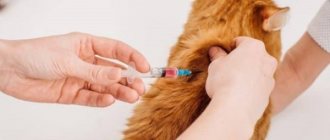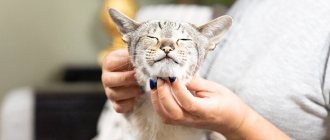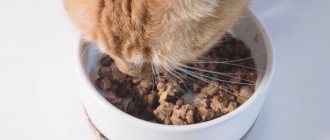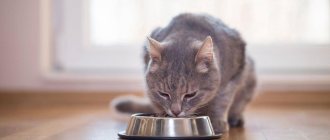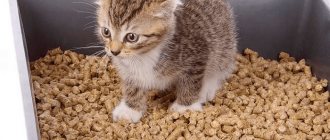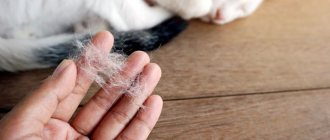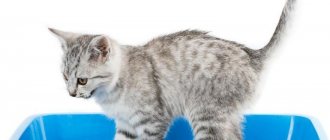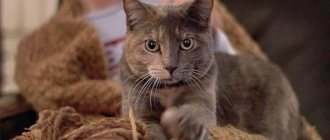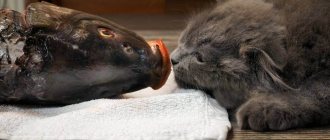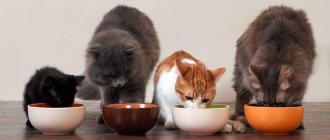Massage has long been known for its healing properties. It can relieve pain, help you relax, and even promote faster healing. The massage therapist must act carefully and correctly for it to truly bring benefits. The article will not only tell you how to massage a cat, but also tell you why and when to do it. Pleasant stroking and pressing will calm you down during a trip or upon returning home, strengthen the bond between pet and owner, and help you survive unpleasant procedures. Aging cats, whose muscles and bones can ache from age and overload, especially love massage. It will remind little kittens of their mother.
General information about constipation in cats
Constipation is not a trifle, but a serious deviation. Before self-treatment, you need to weigh all the pros and cons. You may not know, but even such a harmless measure as abdominal massage for constipation there are contraindications .
Let's start with the basic concepts - what constipation is and why it occurs. Constipation is the stagnation of stool in the colon for a day or more. In theory, a cat should go to the toilet at least once a day, but in practice this does not always happen. Depending on the animal's metabolism, bowel movements may occur once every two days. Constipation in an adult cat is defined as the inability to have bowel movements for more than 3 days.
As stool accumulates, the intestines absorb water from them. Feces become dry, hard, and compressed, making attempts to defecate painful.
Note! Constipation is often caused by chronic diseases, such as colitis. Also common causes of constipation include urolithiasis, which irritates the mucous membranes of internal organs.
What is constipation and how does it manifest?
Constipation, or coprostasis, in a cat is a dysfunction of bowel movements. The stool cannot move forward and this causes a prolonged delay in defecation. The problem should be taken very seriously. At the initial stage, you can massage your cat if he is constipated, but if it does not help, you should consult a doctor.
Causes of the problem
Before taking action, you need to determine the cause of what is happening. This will help make an accurate diagnosis and help the animal as early as possible. The most common
causes of constipation include:
- chronic and infectious diseases of the gastrointestinal tract;
- tumors in the intestines;
- inflammation of the paraanal glands, resulting in severe pain when trying to defecate;
- the presence of helminths, that is, worms;
- surgeries the animal has undergone;
- a foreign body in the digestive tract, often a hairball;
- poor nutrition;
- excess weight due to a sedentary lifestyle.
It is worth noting that some animals are so capricious and clean that they may refuse to go to the toilet for a long time just because their litter box is not cleaned.
Constipation symptoms
If you are dealing with a characterful pet, he will try to tell you that his litter box is not hygienic. In this case, it is enough to simply change the litter, and the problem will be solved - the cat will stop meowing invitingly and calmly go to the toilet.
You should sound the alarm in the following cases:
- the cat refuses food for a long time;
- the animal is “lethargic”;
- the pet's body temperature rises;
- the animal meows or growls while being in the tray for a long time;
- The cat's belly is swollen and painful;
- there is blood or mucus in the stool;
- vomiting occurs.
It happens that it comes to intoxication and convulsions occur. In the most severe cases, the animal falls into a coma.
If constipation gives way to diarrhea, the cat most likely has enterocolitis, that is, the large and small intestines are simultaneously inflamed.
Causes of constipation
The most common cause, depending on the owner, is an unbalanced diet. For normal digestion and bowel movements, the cat must receive foods with hard fibers. Inexperienced owners often believe that if they feed their pet only meat, it will be healthier. In fact, exclusively protein foods quickly lead to stagnation in the intestines.
Cats are nocturnal hunters, feeding in the wild only on what they catch. The cat eats its prey along with its fur, intestines and its contents. With a natural diet, the ratio of protein to fiber is approximately 10:1–10:2.
Important! If a cat receives an unbalanced diet, in which carbohydrate foods predominate over protein foods, it may also develop constipation.
Constipation can occur due to blockage of the small or large intestine. Due to the cat's curiosity, it may eat something inedible , for example, a piece of rope, Christmas tree decorations, wrapping paper or cellophane. An equally common cause of constipation is excess weight. If an animal is obese, metabolic processes are disrupted, which can lead to the formation of dry feces.
If the cat is healthy
If there are no health problems and you just want to do something nice, then massage procedures for your cat can be done at any time.
© shutterstock
Pediatricians give some valuable advice on how to choose a place and time for a massage:
- After eating, you should wait two hours to avoid causing vomiting or indigestion.
- You need to start the massage when the cat is lying relaxed. You should not distract him from licking, playing and other important activities.
- During the first days, it is better to simply gently and gently stroke the cat, scratch it, accustoming it to prolonged contact, and palpating the body for pain points. If you unexpectedly find a pain point, you should first contact your veterinarian for a consultation.
- While stroking, you need to speak to the animal in a quiet and low voice. High and loud noises will frighten her.
Signs of constipation in a cat
How to determine constipation in a cat if you do not have deep knowledge of veterinary medicine? The most reliable method in this case is observation. During constipation, you may notice that your pet behaves restlessly, often coming to the litter box, but not entering it. It is important to show maximum attention at the early stage of development of the disease.
Note! When constipated, a cat may move into a defecation position, but instead of stool, a clear fluid may be released from the anus. Inexperienced owners often confuse this phenomenon with diarrhea; in fact, it is constipation.
When defining constipation, it is important to understand that passing too much dense, fatty stool is also not considered diarrhea. This condition may be the result of an unbalanced diet and too high a percentage of fat in food.
Squeezing feces
In most cases of spinal cord injury, cats retain the ability to defecate on their own. However, if the sacral region is damaged (for example, due to injuries that lead to the avulsion of the tail), fecal incontinence may occur. As with lower motor neuron type damage, the only way out for such animals is a diaper, since feces will constantly be released. However, in some cases, manual squeezing of the bladder can also stimulate the intestines, which will lead to bowel movements. It is not recommended to massage cats with constipation - first you need to find out the reason that led to constipation, this could be either unsuitable food or more serious pathologies.
Treatment of constipation in cats without the use of medications
Treatment of constipation at home should begin with gentle measures. Refrain from using medications if the animal's condition allows.
Abdominal massage is considered a relatively safe technique. However, before doing a massage, it is important to compare the clinical picture with the symptoms of colitis and volvulus:
- For colitis and similar diseases, massage will not be beneficial, but will be accompanied by severe pain.
- When intestinal volvulus occurs, massage is useless and a waste of time.
Important! If a pregnant cat is constipated, massage is contraindicated.
There are no universal techniques for massaging cats. Much depends on the animal’s temperament and its condition.
Massage technique
Before the procedure, the pet needs to be prepared. You should not start massage immediately after eating. However, the cat should not be hungry either. In this case, she will not be inclined to contact the person.
It is advisable to carry out the procedure 1.5-2 hours after a light meal.
The cat should not be distracted from activities that are important to him, such as playing. It is advisable to wait until the pet lies down to rest, is calm and relaxed (waking the cat is unacceptable). Before moving on to the main actions, you need to pet the cat and talk to him. The most convenient place for a massage for cats can be the owner's knees. However, if your pet has a favorite place in the apartment (chair, rug), you can carry out the procedure where the animal feels especially comfortable.
Technique to follow:
- You should start massaging not from the stomach, but from the ears and muzzle. Then the hands move through the chest to the stomach. Such actions will help to avoid an inadequate reaction of the pet to massaging.
- Abdominal massage begins with light stroking with the palm in a clockwise direction. The muscles should completely relax. Gradually the pressure may increase. It is forbidden to put too much pressure on the stomach. This can lead to rupture of internal organs. At the first manifestations of a negative reaction, the pressure needs to be eased.
- At the same time as your belly, you can continue to stroke your ears and muzzle with your other hand.
The procedure lasts no more than 5 minutes. If you are prone to problems with stool, massage can be done daily or 3-4 times a week. Animals do not need to use oils or massage creams for the procedure.
What to do if massage doesn't help?
What to do if massage doesn’t help, and there’s no way to go to the vet? At home, it is permissible to use gentle laxatives.
A relatively safe remedy is flaxseed oil, which the animal will have to forcefully drink. One teaspoon of oil is enough for an adult cat. After taking the drug, the animal’s condition should be monitored for 2–3 hours. If the cat has not become interested in food and bowel movements have not occurred, it is necessary to use a medicated laxative.
All laxatives have a number of contraindications and side effects and are prohibited for use in cases of bleeding, attacks of colitis or peptic ulcers. As practice shows, in mild cases of constipation, contact laxatives in the form of enemas and suppositories help well.
During constipation, the animal’s body suffers from intoxication, but the use of adsorbents is not always relevant. The fact is that almost all sorbents absorb water, and in case of dehydration and intestinal blockage, dry feces will only worsen the situation. To reduce intoxication and irritation of the intestinal mucous membranes, you can use Enterosgel diluted in water or coating agents, for example, Phosphalugel.
In what cases is massage prohibited?
The owner should know when massage helps against constipation, and when it can be dangerous. The procedure is contraindicated in:
- intestinal diseases;
- pregnancy;
- skin lesions in the abdominal area (traumas, burns, dermatological pathologies);
- hernia;
- inflammatory processes;
- exhaustion of the body;
- vomiting;
- elevated temperature;
- convulsions;
- mechanical blockages of the intestines;
- fractures of the pelvic bones;
- spasms of the large intestine;
- tumors of various types.
You should also refuse a massage if the animal reacts inadequately to it - growls, bites the owner, etc. The cat is not able to communicate its feelings. She might be in pain. The procedure is not performed on cats that have recently given birth and those animals that have undergone surgery in the abdominal area less than 5 months ago.
How many sessions are needed for recovery?
It is important to understand that massage is not a universal treatment for osteochondrosis and other pathologies of the musculoskeletal system and can only be used as an effective addition to other methods. To achieve a stable result, you usually need to take 1-2 courses, each of which consists of 5-10 sessions. The duration of one session is usually from 15 to 25 minutes. Improvements appear by the end of the first course, but pronounced positive dynamics are diagnosed after 2 courses of treatment.
Positive dynamics are observed after two courses of massage
Note! After the first sessions, back pain may worsen. This condition is normal, since the muscles need time to recover and adapt to the new condition. This usually takes about 48 hours. Such pains usually disappear after 3-4 sessions.
Video - Features of therapeutic massage for thoracic osteochondrosis
Massage is an effective remedy for the treatment of osteochondrosis and other diseases of the musculoskeletal system, which can be used after regression of acute symptoms. For the treatment to be effective, it is important not only to follow the technique, but also to adhere to the recommendations for preparing for the procedure and behavior during the massage. To achieve the desired result, two courses of 5-10 procedures are usually sufficient.
Massage and water treatments
To cure osteochondrosis of the thoracic region, it is recommended not only to attend massage sessions, but also to do therapeutic exercises. A special course of exercises is selected by a physical therapy doctor after a comprehensive diagnosis. You can find out which exercises are the most effective from the article on our website.
Preparatory stage
The first thing you need to remember is that a cat is a whimsical creature, it requires a special approach. You should not massage your cat when she resists touching her belly. She can only allow someone she trusts to access this part of the body. To ensure a successful massage, consider these rules:
- Postpone the massage until later if the cat is busy licking its fur, playing with a ball, or hunting for an imaginary mouse. After she eats the food, about 2 hours should pass.
- Massage should not be perceived as a special manipulation. Combine it with affection, tenderness and play. Talk to the fluffy one, stroke the body. The cat should relax.
- It's good if your cat likes to lie on your lap. Then it will not be difficult to get a massage. But if the animal is sitting on a sofa or easy chair, this is also a convenient option.
Diagnosis and treatment
Finger or hardware impact on the gland is carried out to collect secretions. If the patient experiences stagnation, the accumulated secretion is a favorable environment for bacteria, which can provoke the appearance of a focus of inflammation.
There are therapeutic benefits of prostate massage. The effect is prescribed to restore the gland ducts and ensure adequate outflow of stagnant secretions. Massage has a positive effect on muscle tone, improves blood supply to the area, and ensures venous and lymphatic circulation.
Massage technique
The technique is quite simple:
- Stroke the top of the tummy a couple of times.
- Continue gentle stroking down to the groin area.
- Massage your belly with circular movements.
- Using kneading movements, go from the edge of the ribs to the bottom of the belly, but act gently, do not overdo it.
- Gently move from the bottom of the tummy to the top using pulling movements three times.
- Repeat steps 4 and 5.
- Strokes left and right, moving from top to bottom.
- Finish the massage with light pats on the belly.
It is not necessary to strictly follow all the points in a row; they can be swapped. The main goal is to stimulate peristalsis.
Check with the doctor
What you need to pay special attention to
Even the most professional massage for a cat can result in snorting and attempts to escape. Therefore, you must always listen to the animal’s mood. Attempts to get up, leave, grumbling signal an unwillingness to endure the procedure, while sharp twitching, screams and moans indicate that there is a problem and help is needed. If you suspect a reaction of pain in the cat's body, you need to immediately interrupt the massage, remember the problem area and monitor the cat's behavior. If possible, inspect it for scratches, bumps and injuries.
The desire to give your animal a massage is an excellent reason to examine your pet’s fur and skin. The fur should be dry, pleasant to the touch, without lumps or dirt. The skin should be free of bumps, bite marks and irritation.
Benefits of massage
The therapy will not take much time - a maximum of 20 minutes. But the effect of the procedure can improve the health of your mustachioed friend. The positive aspects include the following:
- Regular massaging of the tummy or back reduces the need for laxatives by forty percent. This is convenient if the animal is already old, peristalsis is reduced and the tailed animal cannot cope with bowel movements on its own.
- Works as a prevention of flatulence.
- Helps eliminate or prevent other digestive problems. But only if massaging is carried out regularly.
This is an affordable method that does not harm the cat, especially in comparison with medications.
Benefits and therapeutic effect
Massage is a mechanical and reflex effect on the human body for the purpose of treating and preventing chronic diseases of the musculoskeletal system and internal organs.
Massage helps improve overall vitality and strengthen the immune system
The main clinically significant effect in osteochondrosis (regardless of the location of the degenerative disc) is the normalization of blood circulation and lymph movement in the vessels of the central spinal canal. It is the insufficient blood supply to the cartilaginous ring-shaped plates that form the nucleus pulposus of the intervertebral disc that leads to dystrophy, dehydration and drying of the pulp and irreversible changes in the structure of adjacent vertebrae.
Stages of osteochondrosis
Schematic representation of the degenerative process progressing in the tissues of the spinal column
The improvement in well-being after undergoing a massage course is also explained by increased blood flow in the vertebral arteries, so most patients note the disappearance of headaches, improved appetite, a decrease in the frequency of migraine attacks, and a decrease in the manifestations of vegetative-vascular disorders (including arterial instability).
After completing a massage course, patients’ well-being becomes steadily better
Other healing properties of massage also include:
- improvement of respiratory function (thoracic osteochondrosis often provokes shortness of breath and other manifestations of partial respiratory failure);
- reduction of radicular and myofascial pain;
- increased mobility in the affected segment of the spine;
- elimination of stiffness in the upper back (neck, back of the head, shoulder girdle) after a night's rest or a long stay at rest;
- normalization of sensitivity in the upper extremities.
The effect of massage on the circulatory and lymphatic systems
The effect of massage on the nervous system
The effect of massage on the nervous system.pngmusculoskeletal system
An important effect of massage treatment for thoracic osteochondrosis is the relief of attacks of thoracalgia (intercostal neuralgia). Thoracalgia is pain in the chest that occurs as a result of compression of the spinal nerve endings located at the level of the thoracic vertebrae.
Thoracalgia (vertebrogenic)
During massage, soft tissues (muscles, ligaments) are deeply worked out, which eliminates muscle spasms and reduces compression of the nerve roots, which provokes pain.

